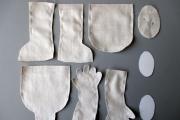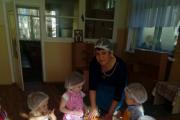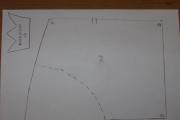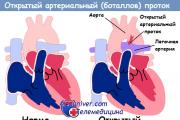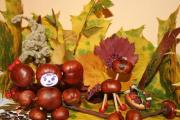Is it necessary to increase the fat content of breast milk and how to do it. What to eat to increase the quantity and fat content of breast milk
Breastfeeding a baby is a great happiness. Breast milk is the ideal food for a child in the first year of life. It is not only easily absorbed by the baby’s body, but also gives natural immunity. In addition, being sterile and at the right temperature, this food does not need to be preliminary preparation. However, breast milk can have different fat content. If this indicator is too low, then the child does not gain weight well and also constantly feels hungry. Therefore, young mothers should know how to increase the fat content of milk and thereby increase the immunity of the baby.
What determines the fat content of breast milk: factors for increasing lactation
If we look at the standard indicators, then in 100 ml of female breast milk there should be 4.2 grams of fat, 1.3 grams of protein and 7 grams of carbohydrates. The nutritional value will be 67 kcal. Note that in this case we are talking about hindmilk. After all, breast milk is not a solution in its structure, but an emulsion: as it accumulates in the mammary glands, it stratifies. Particles of fat, connecting with each other, are attached to the walls of the ducts and remain behind. Thus, hind milk is more nutritious, its fat content is two to three times higher than that of fore milk, which, in turn, is designed to quench the baby’s thirst (while saturating his body with important microelements).
If a nursing mother has doubts about the sufficient fat content (and, accordingly, the nutritional value of her milk), then she can conduct one test at home. The woman fills the tube with hindmilk (conventionally, this is the milk that remains in the breast after feeding the baby). A mark of 10 centimeters will be enough. After seven hours, the amount of cream formed is measured. Considering that 1 mm is equal to 1% fat content, normal indicator will be 4%. However, this indicator is very conditional, since it is individual for each mother and can change depending on the feeding time and the needs of the child. The main criteria for the required fat content of breast milk are the health status of the baby and its weight gain.

The fat content of breast milk can be easily determined at home by doing a test
You should know that the fat content of breast milk depends on many factors.
What you need to know about women's hormones and heredity
The hormone parameters are determined genetically, and heredity plays a determining role. Each woman has her own hormonal levels, in particular the level of prolactin and oxytocin, which directly affect lactation. Already during pregnancy there is a change hormonal levels- increased prolactin begins to be produced, stimulating milk production. The body independently prepares to feed the expected baby. After childbirth, its indicator increases even more.
As for oxytocin, this hormone is produced directly during feeding, when the baby stimulates the nipple with its lips. At the same time, the mother feels a characteristic tingling in her chest and feels a rush of milk. By the way, oxytocin also causes uterine contractions during feeding in a woman who has recently given birth.
An increase in lactation is possible only with an increase in the production of appropriate hormones. Prolactin production depends on correct grip nipple, frequency of attachments and the presence of night feedings (from 3 to 8 am). The production of oxytocin depends on emotional state women. With more frequent and long feedings The fat content of breast milk increases.
We increase the physical well-being and psychological comfort of the mother
Of course, the quality - as well as the quantity - of breast milk is related to the health of the young mother. Physical well-being (absence of acute and chronic diseases) is undoubtedly very important. But no less important role plays a role in the psychological comfort of a nursing woman. Absolute peace, absence stressful situations, regular good rest (primarily sleep) is a guarantee good quality feeding, and the amount of milk. A young mother should also avoid noisy places and active sports.
During feeding, nothing should distract mother and child; their close contact, skin contact, and affectionate gaze are of great importance. It would be useful to turn on quiet, pleasant music.

Emotional peace - the most important condition good lactation
Time of day and seasonality: when is breast milk richer?
It turns out that breastfeeding periods also affect the fat content of breast milk. The composition of this food is different in different times 24 hours: at night, milk is higher in fat and calories than during the day. This is due to the fact that at night, especially after three hours, the hormone prolactin is produced twice as much as during the day. This is why nighttime breastfeeding is especially recommended for children who are not gaining weight well. For mom, this will be an excellent prevention of lactostasis.
As for seasonality, summer milk contains more water than winter milk. It is programmed by nature itself so that the baby’s needs are maximally satisfied at a certain point in time. In the summer, a nursing mother consumes much more liquid, which affects the density of her milk. Breast baby, in turn, in hot weather also needs more liquid food.

Summer milk is thinner
Requirements of a child's body for breastfeeding
In order for the baby to receive milk of the required fat content, the mother needs to adhere to the basic rules of feeding. Since the greatest nutritional value carries the so-called hind milk, then during feeding you need to give the baby only one breast so that he empties it as much as possible. The fattest droplets stick to the walls of the milk ducts and the baby eats them at the end of feeding. If after this the baby is still hungry, then only then is he offered the second breast.
In addition, the fat content is directly proportional to the frequency of the baby's breastfeeding. If you feed a baby with long breaks, then he will have to suckle for a long time, which is thinner. If the mother wants to provide the child with fattier food, then she should put it on a half-empty breast: milk in this state will be higher in calories.
You should know that the calorie content of milk is also influenced by the age of the child: by the age of two, this figure increases. An interesting fact is that if the baby was born premature, the composition of the mother’s breast milk (calorie content) will be adapted to his diet.
What foods increase the caloric content and nutritional value of breast milk?
What should a nursing mother do to increase the fat content of breast milk? You often hear how restless relatives vying with each other to advise a young mother to eat for two so that her milk is more nutritious. However, as studies show, increased nutrition does not affect the fat content of breast milk at all. The principles of nutrition for a nursing woman are balance and variety. The body itself will tell you what it needs and in what quantity.
Half of mother's diet daily norm should be vegetables and fruits (certainly in fresh), and also various cereals. Among the vegetables, the most notable ones are cauliflower, broccoli, carrots.

Fresh vegetables and fruits are the most important part of a nursing woman's diet
Products that increase the nutritional value of milk are also walnuts and halva.

Walnuts improve the quality of breast milk
Halva, like any sweet, is eaten at small quantity so as not to cause flatulence and intestinal colic at the child. And in order to avoid the development of allergies in the baby, the mother should not consume more than three walnuts per day. To diversify the menu, you can add chopped nuts to hot dishes. cow's milk. This mixture is infused for a little over an hour and drunk in small portions throughout the day.
In general, milk, cow or goat, and its derivatives (kefir, cheese, sour cream, cream, cottage cheese, butter) not only increase the calorie content of breast milk, but also saturate it with calcium - a valuable microelement. You cannot replace natural butter with spreads.

Drinking milk by a nursing mother is the key to good lactation
In addition, the fat content improves when eating beans and raisins. Pumpkin and sunflower seeds are also useful. To improve the taste, they can be fried in a dry frying pan.
All types of legumes are considered to be foods that cause increased gas formation, constipation and colic in the baby.
Fish in the diet of a nursing mother should be fatty varieties - mackerel, pink salmon, horse mackerel, tuna, sturgeon, etc.

Fatty fish varieties promote the absorption of vitamins and increase the nutritional value of milk
You can eat different types of meat, white or red, certainly boiled or steamed (you should remember that some varieties, for example, chicken, can cause allergic reactions in a child). The liver is also useful.
Liver - filling and useful product, which should be in the mother’s diet subject to quantitative restrictions, but can cause food allergies in the baby. You should not eat liver if your child develops a rash, redness, or digestive disorders.

Eating red meats has a beneficial effect on the quality of milk
In general, meat and fish intended for feeding a nursing woman should be boiled, stewed, steamed or baked. Fried and smoked food is prohibited during this period (as are various sausages). To add flavor, use greens.
A woman while breastfeeding should receive 30% fat and 20% protein from food daily. As for carbohydrates, they should be obtained from cereals and fruits, and the consumption of baked goods and other sweets should be limited as much as possible, since they contain so-called simple carbohydrates. They add extra pounds and at the same time do not carry much nutritional value.
It should also be mentioned optimal quantity meals. Meals should be fractional. The entire daily volume is divided into five to six small doses. In addition, during lactation it is unacceptable to lose weight suddenly: this will affect not only the quality, but also the quantity of milk.
Sometimes low fat content of breast milk is accompanied by insufficient production. In this case, the correct drinking regime will help solve the problem. Half an hour before feeding the baby should be consumed healthy drinks from the following list:
- warm tea (preferably green), with the addition of milk or cream;
- ginger tea;
- carrot milk or carrot cocktail (medium-sized carrots should be finely grated and mixed with half a liter of hot milk; if desired, a teaspoon of honey can be added. But do not overuse honey - it is an allergen. The drink is consumed in warm. Take 1 glass twice a day);
- rosehip decoction (the berries are brewed with boiling water and boiled for several minutes, the drink should steep for at least 5 hours);
- natural juice (but not from citrus and exotic fruits);
- lactation teas from anise, fennel and caraway (in bags or ready-made granules that dissolve in water at any temperature).

Note that when increasing the calorie content of breast milk, it is important not to overdo it, since too fatty foods are difficult for the baby to digest and can cause colic, bloating, constipation or diarrhea.
Doctor Komarovsky's opinion: is it necessary to increase the density of breast milk?
Evgeniy Komarovsky, a famous pediatrician, author of books and television shows, in his research touches on the issue of fat content in breast milk and the associated nutrition of a nursing woman.
The doctor’s principles are based on the natural needs of mother and child. According to Komarovsky, there is no need to strive to increase the calorie content of milk through diet. The more fatty it is, the more difficult it will be for the baby’s intestines to work. In addition, such milk is more difficult to secrete from the mammary glands.
A nursing mother, of course, should eat fatty foods, because a number of vitamins are absorbed only together with fats. However, a sense of proportion must be observed in everything. Preference should be given not to animal fats, but to vegetable fats, eating olive, sunflower or corn oil.
Moreover, if a woman does not suffer from overweight, then every day, preferably in the evening, she can eat a portion of semolina porridge. Pediatrician Komarovsky also strongly recommends using sufficient quantity raw vegetables and fruits, while canned ones should be removed from the diet during lactation.
Doctor Komarovsky about breastfeeding - video
How to increase your milk supply - video
How you can influence the quality of breast milk - video
When breast milk is the main source of nutrition small child, then, of course, its quantity and quality matter. However, when it comes to the fat content of milk, the mother should not be guided by her own assumptions, but should carefully evaluate the baby’s well-being and changes in his weight. If the child is active and cheerful, then most likely everything is fine with nutrition. If breast milk is really not fat enough, then best way fix the situation - proper diet for a nursing woman.
Despite the fact that we are all children of civilization and urbanization, we are far from being in the first generation, modern world This “peasant” stereotype is still strong: “Fatty foods are the healthiest for the growth of small children.” That is why the question of how to increase the fat content of breast milk worries every nursing mother - after all, she, too, like her ancestor three or four generations earlier, naively believes that the word “fat” itself is an indisputable synonym for the expressions “healthy”, “well-fed”. ", "strong"... But in reality: is the fat content of breast milk really so important for the health of the baby?
Every milk has its time!
Breast milk tends to change dramatically as the baby “ripens” and grows: for example, the milk of a woman who has literally just given birth will be radically different in fat content and composition from the milk of a mother whose baby is about to reach its first year.
As a rule, breastfeeding specialists distinguish three stages of “maturation” of breast milk: primary milk (colostrum), transition milk And mature milk. Each of these “products” is extremely beneficial for the baby. We’ll talk about the charms and properties of each of these “varieties” separately and in detail...
But in addition to “age-related” changes in the composition and fat content of breast milk, there are also changes within one feeding - in other words, for the first 5-7 minutes the baby sucks milk from the breast, the composition is significantly different from what he will suck at the end of feeding ... And we will tell you about this too!
The first milk is colostrum: compound benefits
It is impossible to find food more beneficial for a newborn baby than his mother’s first breast milk, the so-called colostrum. However, colostrum is considered invaluable for the baby’s health not because it has any supernatural fat content. The true benefit of colostrum is that it contains record number nutrients and protective substances.
It is interesting that, in its physical chemical composition Colostrum resembles blood more than milk. In addition, colostrum is extremely low content water, which protects the baby’s still weak kidneys from “overload.” But what colostrum contains in excess is vitally important immune factors(which provide the newborn with so-called passive immunity) and growth factors - special substances that stimulate the growth and development of the child in the first days of life.
Colostrum is extremely high in calories (its energy value is significantly higher than mature breast milk), so its not too abundant production should not frighten a nursing mother. For example, the protein content of colostrum ranges around 11-15% - which is almost three times more than mature human milk.
Therefore, even with a very modest portion of colostrum (as a rule, about 20-30 g of primary milk is produced per feeding), a newborn baby is able to satisfy all his nutritional needs.
But as for the fat content of colostrum, it is slightly lower than that of mature milk - in this way nature took care of the child, who in the first days of life still finds it difficult to digest and break down more fat. At the same time, the fat content of colostrum is quite sufficient to ensure easy for baby laxative effect, and help get rid of meconium (first stool), thus reducing the risk of diarrhea, the culprit of which is bilirubin, which accumulates in meconium at the time of birth. In this context, many modern neonatologists consider low-fat colostrum not only as infant food, but equally as medicine.
Fat content and composition of milk during the transition period
3-5 days after birth, primary breast milk gradually begins to change in composition and quantity, turning into more mature milk - the protein content drops significantly, but the fat and sugar content increases. All these changes are determined solely by the needs of the newborn, who is gradually adapting to life “outside, not inside.” The baby needs strength to grow and final formation organs and tissues (therefore, his food becomes rich in fats and sugars), but at the same time he does not yet need a developed muscular “framework” - since he is not yet able to move a lot, run, jump, etc. So the protein content in transition milk is fairly low - as they say: what is the demand, so is the supply.
The composition and fat content of breast milk changes - accordingly, its taste and color change. Compared to colostrum (which has a "thick" yellowish tint) transitional milk becomes noticeably lighter and sweeter. The taste changes due to a decrease in the amount of salts and an increase in sugar and fat in the composition, and color and density - due to the fact that the milk gradually becomes richer in water.
Does breast milk beat cancer? One of the most amazing things about transitional breast milk is its ability to kill cancer cells. During the period of transformation of colostrum into finally mature milk, substances appear in it, which, when they enter the baby’s stomach, form a special complex - the so-called HAMLET (Human Alpha-Lactalbumin Made Lethal to Tumor Cells).
The HAMLET complex is formed only in children who are on breastfeeding. Why is it good and important? It causes programmed death (in medical terms - apoptosis) of tumor cells, primarily cancer cells.
Namely: the HAMLET complex, which is a “friendly” union of alpha-lactalbumin (whey protein in breast milk, which begins to be produced just in transition period) and oleic acid (a substance found in most animal fats and some vegetable fats), when interacting with cancer cells, “pushes” them to complete self-destruction.
The HAMLET complex was first discovered in the stomach of newborns. Nowadays, scientists have made great bets on this discovery to finally create effective medicine against cancer.
Fat content of mature milk - is it really that important?
Normally, the fat content of mature milk is approximately 4.1 - 4.5%. Not cream at all, as many mothers believe, but not a lean product either. However, it is not the percentage of fat that is considered a measure of quality. mother's milk! So-called high-quality breast milk is milk that is complete in composition.
What and how much should be contained in breast milk? On average, the composition of mature breast milk is approximately as follows (per 100 g of product):
- Water- 87.5 g
- Squirrels- 1.1 g
- Fats(total) - 4.4 g
saturated - 2 g
monosaturated - 1.6 g
polyunsaturated - 0.5 g - Carbohydrates(disaccharides) - 6.9 g
- Retinol (vitamin A) - 60 mcg
- Beta-carotene - 7 mcg
- Thiamine (vitamin B1) - 0.014 mg
- Riboflavin (vitamin B2) - 0.036 mg
- Niacin (vitamin B3) - 0.177 mg
- Pantothenic acid (vitamin B5) - 0.223 mg
- Pyridoxine (vitamin B6) - 0.011 mg
- Folacin (vitamin B9) - 1.5 mcg
- Cobalamin (vitamin B12) - 0.05 mcg
- Ascorbic acid (vitamin C) - 5 mg
- Tocopherol (vitamin E) - 0.08 mg
- Vitamin K - 0.3 mcg
- Calcium - 32 mg
- Iron - 0.03 mg
- Magnesium - 3 mg
- Phosphorus - 14 mg
- Potassium - 51 mg
- Sodium - 17 mg
- Zinc - 0.17 mg
You will be surprised, but today it is reliably known that the composition (including fat content) of breast milk is practically in no way affected by the mother’s diet, or her age and maternal experience, or even her mood. The only real factor that determines the composition and fat content of breast milk is the needs of the breastfed baby.
In other words, a young, 13-year-old mother from the socially disadvantaged corners of Nigeria, and a well-to-do 26-year-old mother from Russia, Switzerland or the USA will have almost the same composition and fat content of breast milk. In this sense, nature has managed to equalize all people on Earth - by feeding on breast milk, we all get approximately the same start for future development and growth.
Fat content of breast milk and mother's diet: what is the connection?
Let us repeat: the composition of breast milk is more or less the same for every nursing mother. More precisely, it is determined solely by the needs of the baby’s growing body. For example, if at some stage of growth and development a baby urgently needs calcium, then this same calcium will increase in his mother’s milk.
It is important to understand that it is not you, as a nursing mother, who shapes the composition of your breast milk, but your baby, who needs certain nutrients Oh.
And no matter how carefully you adjust your diet, by and large it has no effect on the fat content, composition and taste of breast milk. This pure water myth - a theory that infant“eats” the same thing as his mother. No, that's not true.
A joint study by Norwegian and British scientists showed that in nature there are only two products that can significantly affect the taste and composition of breast milk. Only two! It's garlic and alcohol. But if babies suck “garlic” milk with pleasure and thirst, then on the contrary, they don’t like breast milk “under the influence” - they don’t like it so much that they may give up breastfeeding altogether.
A newborn and an older baby, being breastfed, receive the set of nutrients that he needs depending on his state of health, period of development, etc. If a nursing mother allows a certain deficiency of certain substances in her daily diet (consumes little protein, or, for example, little calcium), the baby will still take his dose. Only to the detriment of the mother’s health.
A complete, balanced diet for a nursing mother is needed primarily by the mother herself. Because if there is a deficiency of certain substances, the baby will still take them, but not from the mother’s diet, but from the mother’s body.
With fat content, the story is exactly the same as with the general composition of milk - mother’s milk will have exactly the same percentage of fat content that is necessary to meet the nutritional needs of a growing child. On average, remember, mature human milk, has a fat content of 4.1 - 4.6%.
Another thing is that due to typical mistakes When breastfeeding, the mother may unwittingly not give the baby some of what he needs full fat milk. The point is that Mature breast milk is conventionally divided into:
- foremilk (it has more water and less nutrients)
- hind milk (it is denser and contains maximum fat and nutrients)
Foremilk- the baby sucks it out at the beginning of feeding - it is essentially a drink for the child, with it he quenches not hunger, but thirst. The baby receives foremilk in the first minutes of attachment to the breast.
But hind milk- there is nothing more than a hearty, complete “breakfast, lunch and dinner” for the baby. The baby begins to receive hind milk after the front milk has dried up.
Mother’s milk (this means hind milk) can be super-nutritious and quite fatty, but if the mother often changes breasts during feeding, then in the end it turns out that the baby drinks front milk all the time, simply not having time to “get” to what he needs rich and rich hindmilk.
The result is a situation in which the mother has full-fat, dense milk, but her child is losing weight day by day, as if he were eating only water...
How to check the fat content of breast milk at home?
Exists simple way check how much fat your breast milk is. However, don't rely too much on this indicator - in reality, it means absolutely nothing. In 95% of cases, mothers, having measured the fat content of their milk, “fall” into the statistical norm (from 3.6 to 4.6% fat). But even if your particular milk turns out to be slightly less or slightly more fatty than these figures, this will only indicate individual characteristics and the needs of you and your baby, that’s all. The main indicator that is directly related to the baby’s nutrition (that is, it demonstrates how fully and sufficiently the child is fed) and to his health are always the same: this is the dynamics of the baby’s height and weight gain.
And yet, if you are itching to measure the fat content of your breast milk, go ahead. Take an ordinary test tube (at any pharmacy) and express hindmilk (this is important!) into it to a height of 10 cm. Then leave the tube for about 5-5.5 hours at room temperature. Over time, the milk will separate into fractions, the topmost being fat. Measure this creamy layer with a ruler: how many mm is the result, so is the percentage of fat in your milk.
How to increase the fat content of breast milk?
No way. Firstly, solely because this action makes no sense. Even if you manage to increase the fat content of your “product” to 6-7%, this will not affect the baby in any way - he will take his 4%, and the rest of the fat will remain with you, gradually increasing your waist circumference.
Also, keep in mind that by consuming fatty foods in your diet, you will not be able to change the overall fat content of your breast milk, but you will be able to change the fat composition. Breastfeeding specialist Irina Ryukhova warns: “The composition of milk fats depends on the mother’s nutrition, but not the total fat content, so it makes no sense to lean on fatty foods. The milk will simply become more viscous and the likelihood of stagnation (lactostasis) will sharply increase.” In addition, given the increase in the density of milk, prepare for the fact that it will become more difficult for the baby to suck it out, and he may simply refuse the breast.
Milk is worth its weight in gold!
There is no need to philosophize over the composition and fat content of breast milk, trying, like a real alchemist, to turn into “gold” what is already worth a lot. Your breast milk - just as it is - is the most useful, priceless, vital food for your baby. You should not try to experiment with changing its quality, quantity or fat content.
The wisest and most correct thing you can do on the way to the well-deserved title “Ideal Nursing Mother” is to put your baby to the breast as often as possible (and pump correctly from time to time). In this case, nature and your own brain will do their job: the milk will become both quantitatively and qualitatively absolutely ideal for your little one.
About what is right and balanced diet is collateral good health, no need to remind once again, almost everyone already knows about this. It is also natural that the diet of a nursing mother should be complete, varied and rich in beneficial compounds.
What to do if suddenly you notice that your milk has become fattier than usual or has simply become different?
So, according to the advice of nutritionists and pediatricians, a nursing mother should eat exactly the same as she did during pregnancy. A baby, accustomed to a certain chemical composition while still in the womb, will love it until he sits in a high chair and begins to feed on his own, but even then, he will give preference to those products that he loves Mother.
It is a misconception that the foods that the mother eats end up in milk; this simply cannot happen, because it is not the stomach that participates in its formation, but the lymphatic system and blood. Its composition is determined by the composition of the blood and the activity of certain endocrine glands; only “allowed” microelements can enter it, and those that can “pretend” to be such, for example, ethanol compounds and disintegrated parts of nicotine, as well as some other chemical elements.
You should forget about various grueling diets during the feeding period, wait until the baby sits in a high chair, and only then take care of your body. But you shouldn’t eat everything in a row either, yes, by eating yourself, you feed two, but remember, a baby lying in a pali crib doesn’t need much; on the contrary, by loading your body with excess food, you not only injure yourself, but also change composition of breast milk. It is because of an excess of, say, carbohydrates and fats in the mother’s blood that its fat content increases. It is better to eat more often, but in small portions, and also carefully monitor what you eat. Be aware of seemingly harmless products such as yoghurts, whey, cheeses, etc. May contain harmful additives, dyes and flavors.
Don’t forget about the seasonality of the product; you probably understand that cheap apples sold in winter were clearly not brought from warm shores, but grown in one of the greenhouses near Moscow, using wild amounts of nitrates and stimulants. It’s better to buy two or three expensive African apples than a couple of kilograms of something terribly harmful. Better yet, make some supplies from the summer, make some jam and dry the fruit.
According to WHO research, fat content depends more on seasonal factors than on the food consumed, as well as on the duration of feeding. Thus, it has been proven that if a baby suckles at the breast for more than 30 minutes, then he receives a larger amount of richer and fattier hind milk.
But what exactly can happen if the fat content of milk suddenly increases?
Firstly, full-fat milk can cause a child to refuse breastfeeding, secondly, it can cause allergic reactions and, finally, provoke intestinal upset. But all this does not mean that you need to breastfeed your child for less than half an hour or eat only low-fat food, no, this will only ruin everything, a baby who has not received the proper amount of fat will not be able to eat on his own for a long time, sitting in a high chair. since its development will be slow. There is no need to go to extremes, just trust your body and control your diet, and also, it will not be superfluous to monitor your baby’s stool and regular visits to the doctor.
Young mothers often think about how to increase the fat content of breast milk. It seems to them that the child does not get enough to eat, so he cries regularly. It is not recommended to take any measures on your own to change the composition of milk without the advice of a specialist, because this can negatively affect the weight of mother and baby.
Benefits of breastfeeding
During pregnancy and also after birth process female body secretes colostrum. The substance contains immunoglobulin A - a protective element against various bacteria that are fraught with danger. Colostrum contains large number leukocytes, whose main function is the destruction of viruses. To strengthen and quickly adapt to environment The baby's body needs to carry out the first breastfeeding within a few hours after the baby is born.
Over time, colostrum is replaced by milk. To speed up the transition process, it is recommended to put your baby to the breast more often. After three weeks, the amount of milk increases sharply, and there is a danger of mastitis or lactostasis. To avoid such troubles, you should feed your baby on demand. This method can also increase the fat content of breast milk. The mother should regularly monitor the baby’s condition, stool frequency and urination.

How to check if your baby is eating
It is recommended to visit your pediatrician monthly to monitor your weight gain. In the first quarter of life, the baby gains on average from 600 to 900 grams. per month, in the second - 400-600 gr., in the third - 300-500 gr., in the fourth - 100-300 gr. These standards are mainly used for bottle-fed infants. If we talk about infants, the indicators may differ slightly. A significant smaller difference deserves the attention of parents. IN in this case You should think about how to increase the fat content of breast milk. Currently, there are a large number of specialists who can provide assistance in this matter.
The less often a mother breastfeeds her baby, the less nutrients there are in the milk. This is reflected in his mood and the number of diapers used per day. The more often your baby pees, the more likely it is that he is full. This is not so easy to see in a diaper, so you should take it off for about three hours and see how many times the act of urination is repeated. Normally, this indicator should exceed 3. If the indicator does not reach the desired level, you need to consult a doctor with a question about how to increase the yield of breast milk.

If feeding is established, then the baby receives food of the proper quality. Breast milk is the most a unique product, which cannot be replaced by a mixture. Many manufacturers baby food they are trying to produce a product similar in composition to natural food, but this is impossible to do. Scientists cannot fully decipher all the elements of breast milk. Its composition changes regularly depending on the mother’s mood, diet, amount of fluid consumed and much more.
Just for fun, every mother can easily measure the fat content of her milk without leaving home. It is necessary to purchase a test tube, the height of which can vary from 130 to 150 mm, and fill it with “hind” breast milk. After this, you need to leave the vessel open under conditions room temperature for 7 hours, and after the allotted time has passed, measure the layer of the resulting cream (the percentage of fat content is equal to one millimeter). By generally accepted standards, the figure should be 4%.

How to increase your fat level
All mothers have knowledge that breast milk is divided into “front” and “hind”. The first variety is more different light shade. The baby receives this milk to quench his thirst, since the fat content in it is minimal. If the baby falls asleep within 5 minutes of feeding, it is advisable to express a little “natural food” so that the baby receives more nutrients from hind milk, which has a sufficient level of fat content. Not recommended frequent change breast during one feeding.
If necessary, you can increase the volume of hindmilk. To do this, it is advisable to put the baby to the breast more often. This increases the fat level.
Pediatricians believe that the composition of milk does not always directly depend on the diet of a young mother. They say that the lactation process occurs thanks to lymph and blood, so it does not matter what foods a woman consumes. However proper nutrition promotes smooth functioning of the whole body, which contributes to the further production of high-quality and fatty milk. Food always plays an important role in a person's life, so you should carefully choose fresh and balanced food.
Foods that increase fat levels in breast milk
First of all, the diet should be varied. Fruits and various cereals should occupy special place(at least 50 percent) on the menu of young mothers. Carbohydrates should always be present in food. The amount of fatty foods should not exceed 30 percent. Vegetables are essential and important products for a woman. The preferred level of protein food is 20 percent. This includes beef, veal and lean fish. The diet should be dominated by following products: milk, cottage cheese, beans, cabbage, spinach, fish and meat. If a nursing mother has any doubts about the level of fat content in breast milk, she should contact specialists who will take necessary tests and choose a suitable diet. It is necessary to exclude all smoked and fried foods, because they can cause colic in the baby. Products that increase the fat content of breast milk, such as milk and cottage cheese, are responsible for the calcium content, and they also increase the calorie content of “natural food” for the baby.

A new mother should drink as much fluid as possible per day. If necessary, specialists can prescribe a special tea that helps increase lactation and milk fat content.
Possible harm from too fatty breast milk
It should also be borne in mind that increased fat content in breast milk is often the result of intestinal upset in the infant, because digestive system the child is not yet prepared for splitting large quantity similar food.
Komarovsky, like other pediatricians, talks about the dangers excess weight in a baby. Parents must monitor all indicators of the baby. Experts are confident that it is better for a child to be underweight than overweight. It is worth considering that consuming products with high level fat content will add several kilograms to the young mother. As you know, every woman after giving birth tries to short term restore your figure, so food should be healthy. Before increasing the fat content of breast milk, mothers should consult a qualified specialist, this is the only way the woman will not harm her figure and feed the baby.
Conclusions
After the birth of a child, doctors recommend using food obtained from naturally. After observation, the doctor will be able to make recommendations on how to increase the fat content of breast milk (if necessary).
In addition to nutrition, experts advise women to monitor their condition, namely, rest more often and get enough sleep if possible. Oxygen is also indispensable for a young mother and baby, so it is worth taking walks in the fresh air more often.

The baby should always feel safe and protected. Milk production directly depends on the moral and physical health moms. IN free time you can do yoga, do morning exercises, because sports can always improve your mood. Breast milk is of particular value to a baby. This article will tell you how to increase the fat content of this product, but before making independent attempts, you need to consult your doctor.
When a baby's main diet is breast milk - great attention is paid to its quantity and quality, including young mothers who are very interested in the fat content of breast milk, whether it is sufficient for a small child.
Different pediatricians have different opinions on this topic. For example, there is an opinion that the baby’s stool, its consistency and frequency depend on the fat content of breast milk. And the more watery the mother’s milk, the more often the baby’s stool, its consistency is liquid. But with a large percentage of fat, above the average 4%, on the contrary, the baby has rare stools. Is this true?
As for the frequent and loose stool, then this is the absolute norm for infants. The stool becomes denser when complementary foods are introduced to the baby. And so, the baby can have bowel movements up to 7 times a day normally. If the stool becomes foamy, colic is often tormented - we can talk about lactase deficiency or a borderline condition with it. Foremilk contains a lot of milk sugar - lactose. This sugar irritates the intestines. But foremilk has little fat content. Therefore, they say that when a woman produces a lot of milk, it is not good. How to increase the fat content of breast milk in this case? We need to stop taking measures to increase milk production. For example, many women pump in the old-fashioned way after each feeding. Thus, they constantly increase the volume of milk. But the child does not need so much of it. And it turns out that the baby sucks mainly foremilk. And the mother expresses her hind milk and pours it out. Not pumping, feeding more often and holding the baby at one breast for a longer time - this is what to do if a nursing mother's breast milk is not full-fat.
If a child’s stool is rare, then pediatricians often talk about the milk’s fat content being too high. In fact, the absence of stool in infants for several days, if this is not accompanied by a deterioration in the child’s well-being, is an absolute norm. It’s just that mother’s milk is very well and completely absorbed. Whether this is related to the percentage of fat in it is not known. But many doctors recommend giving the child water in such cases to provoke stool. However, for children who are exclusively breastfed and not receiving complementary foods, this is not at all necessary. Although it is allowed, especially in the summer and when it is not possible to breastfeed the child.
From all this, a logical question follows - how to determine the fat content of breast milk at home yourself? In principle, you can do it by eye. To do this, you need to express the milk into a transparent bottle. After a few hours, a crust of fat forms on top.
How else can you check the fat content of breast milk? You can roughly estimate the nutritional value of milk by looking at the color. Usually whitish, clear milk has a low percentage of fat. However, even if this is your situation, do not rush to look for what increases the fat content of breastfeeding milk, since, most likely, you have not fully expressed. The container contains only your foremilk, which is the baby's drink. Not all mothers know how to carefully express their breasts.
An increase in the fat content of mother's milk can to some extent be facilitated by a balanced and necessarily varied diet mother. Special attention need to focus on protein foods. Every day you need to eat about 200 grams of lean meat. It is advisable to consume dairy products, but only if the child does not have an appetite for them. allergic reaction. Vegetables and fruits, of course, are not foods to increase the fat content of breast milk, but absolutely necessary components in the diet of a nursing mother. Especially if she is forced to limit herself, for example, in dairy products because of the child’s negative reaction to them. After all, vegetables contain a lot of calcium.
Among the older generation, there is a widespread opinion that the quality and composition of breast milk depends on what the quality and composition of breast milk depends on - the calorie content of the mother's diet. But scientists who conducted observations proved that nutritional density does not have a significant effect on the quantity and composition of milk. The amount of vitamins and microelements obtained from food may be of certain importance. Thus, with an unbalanced diet, breast milk may contain little ascorbic acid(vitamin C), selenium, iodine, vitamins A and B. However, with normal nutrition the only one biologically active additive, recommended for use by nursing mothers, is potassium iodide, known in Russia as “Iodomarin”. The content of iron, calcium, zinc, copper, vitamin D and folic acid. In any case, it will be in breast milk. what the child needs their content. However, if their quantity is insufficient, the mother’s hair, teeth, and the entire body as a whole may suffer.


